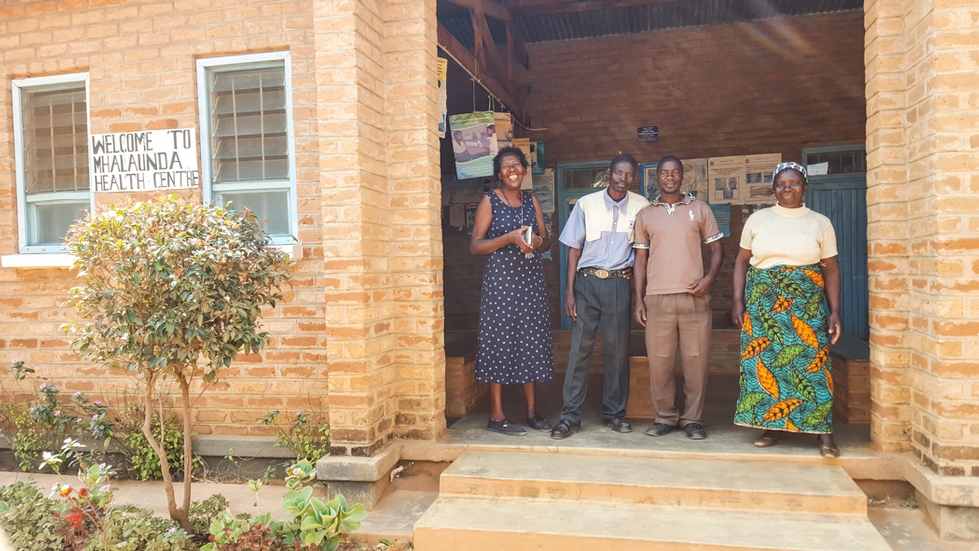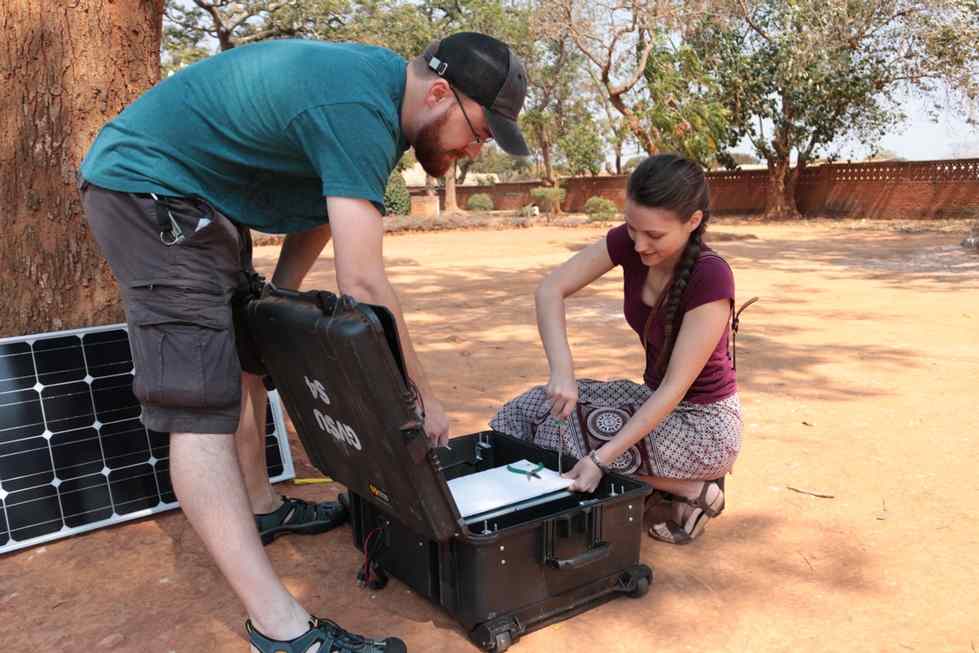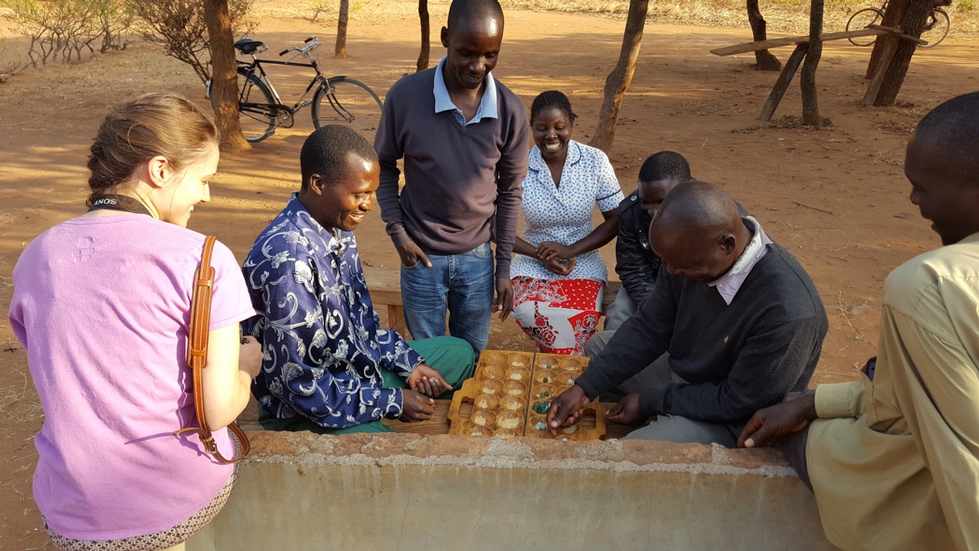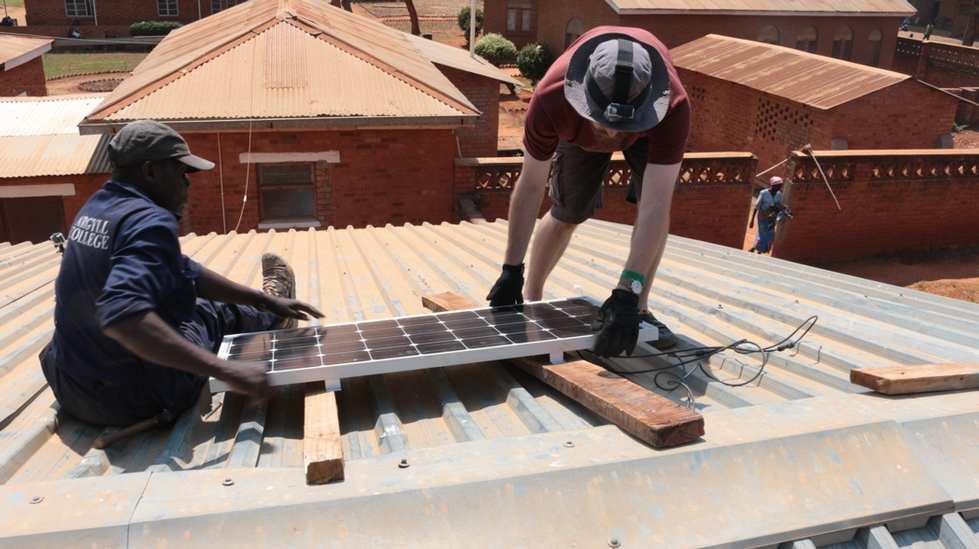Using sunlight to save lives
Student-made devices power African hospital
by Leah Twilley
In a small village in southeastern Africa there is a 114-year-old hospital that serves 100,000 people. Embangweni Mission Hospital in Malawi is staffed by a hospital director and about 225 employees.
People are treated and surgeries are performed, but there is a major problem: the electricity often goes off and it can have fatal results.
Martha Sommers, an American physician, frequently experienced this problem when she spent 15 years working in hospitals in Malawi through the Presbyterian Mission Agency. In Embangweni, where she was director of the clinical department, she often performed emergency surgeries, such as C-sections.

A system was installed at the remote Mhalaundra Health Center, which is not connected to a grid power source. From left, Annie Chavula (nurse), Lesley Saka (guard), Robson Jere (guard), Mphatso Ngoma (housekeeper).
“When the power went out, we relied on a flashlight for light and we no longer had the ability to use a suction tool to clear blood and fluids from wounds,” Sommers said. “This happened many times when we were working to save the lives of a mother and her child. Many times the patient died. Tragedies happened that could have been prevented.”
The hospital has a backup generator that runs on diesel fuel, yet with fluctuating availability and fuel costs, Sommers said the generator was often not an option.
To combat this problem, graduate students in the School of Engineering created a portable power system for the hospital in 2012 that runs on solar energy.
The Photovoltaic Emergency Power System has the ability to provide light and suction power for up to two days at a time. It has since served as a life-saving tool.
The project began when Sommers was introduced to engineering professor Heidi Jiao by her cousin Star Swift, associate professor of management at Grand Valley. Jiao incorporated the project into her graduate course on alternative energy and engineering; Swift also incorporated the project in her classes.
The system was used so often that hospital staff members requested more devices. In August, a group from Grand Valley made the 22-hour trip to Malawi to deliver three new devices to the hospital. The group included Justin Melick, digital media developer for Grand Valley, and engineering graduate students Sofia Fanourakis and Patrick McCarthy.
“When the power goes out, people can die. It’s really that simple,” said McCarthy, a native of Grand Rapids. “For many group projects, the end goal is to get a good grade. For this class, our end goal was to make something that will save lives.”
McCarthy, Fanourakis, and seven other engineering students designed and built the new devices during the 2015-2016 academic year. Each Solar Suction Surgery System — called S4 for short — has five outlets: two provide light, one provides suction and two are used to charge electronics, such as cell phones and tablets.
Since the first system was in use at the hospital, McCarthy said the group had to start designing from scratch, but they followed the original concept. The solar panel is connected to the charge controller which is used to control the output power as well as charging and discharging of the energy storage unit – the battery. Each system weighs between 90-100 pounds and is supported by a sturdy case with wheels.

Engineering graduate students Patrick McCarthy and Sofia Fanourakis prepare to install a Solar Suction Surgery System.
The group spent seven days in August at the hospital and its two remote clinics, located about 45 minutes from the main campus. The Mabiri Health Center receives some electricity from a grid and Maharaunda Health Center is not connected to a grid power source.
The first day in Embangweni was spent repairing damage the devices sustained during the trip and giving a tutorial to hospital management. The next four days were spent installing the solar panels at each location and training employees, including the hospital’s only physician, Ishmael Nyirenda.
Nyirenda and his team use the original power system every single day.
“Each day, there’s a period of at least six hours when we don’t have power,” Nyirenda said. “No power affects our operations and can lead to loss of life. We depend on power to sterilize equipment, perform surgeries and resuscitate babies and patients.”
Each S4 is attached to a solar panel that McCarthy and Melick installed on the roof of each facility. At the main hospital, the solar panel was installed on the roof of the maternity ward, but the tools that were available were minimal.
“The conditions in Malawi required us to get creative to overcome the lack of resources,” Melick said. “We used handmade hammers and hand-forged nails. The most advanced tool we had was the ratchet set we brought with us.”
Melick said having the power to charge cell phones alone could be life-saving.
“The ambulance staff communicate entirely on cell phones, and everyone relies on their phone as the main mode of communication. For it being so rural, it was surprising to see how solid the cell coverage and reception is,” he said.
Powering the future
While the devices provide immediate help, Fanourakis and McCarty are planning for the long term through data tracking. They are tracking power outages, plus the performance of the devices, such as how much power the panels generate, how the batteries perform and what outputs are used most often. The data will be used to help fund new devices and raise awareness about the need for them.
Jiao will continue to offer the solar power system as a group project in her class, with a few changes.

Fanourakis learns how to play Bao, a traditional Mancala board game played in East Africa.
“Some of our constant questions are ‘How do we make this project sustainable?’ and ‘How can we help other areas in need?’” she said. “Malawi isn’t the only area we’re looking at; we want to help other underserved areas in Africa and even in the U.S.”
Jiao wants to eventually have team members train local people how to build, install and repair devices. “The training is more critical than us going there, doing the drop and leaving,” she said. “Costs to ship the devices are expensive and many parts of the system can be purchased locally.”

McCarthy installs a solar panel on the roof of the maternity ward at Embangweni Mission Hospital.
The group partnered with a campus organization to make the system’s design publicly available on a new open-source website called solaRescue (gvsu.edu/solarescue). The website was created by Teaching Through Technology (t3), a multidisciplinary group of alumni and students majoring in computer information systems, engineering, management and marketing. The group encourages the use of technology to serve the global community.
Swift, faculty advisor for t3, encourages people to submit their solar designs to [email protected].
“We’re trying to build a virtual community where designs and solar product concepts are available for anyone in the world to browse and build,” Swift said.
Fanourakis, from Crete, Greece, said solar-powered devices are not new for the people in Malawi and surrounding countries. However, a device that is used to power a suction machine is unique.
“It’s not as easy as grabbing a solar panel and connecting to a battery. It’s more than that. You need to design a device for a specific need. We’re happy to be able to share the design with others who may need it,” she said.
Fanourakis said that, after meeting the people and seeing the need for the S4s, she hopes to continue working with the hospital. “If we could send a person who was prepared with the right tools and expertise, we can continue to do a lot of good there,” she said.
